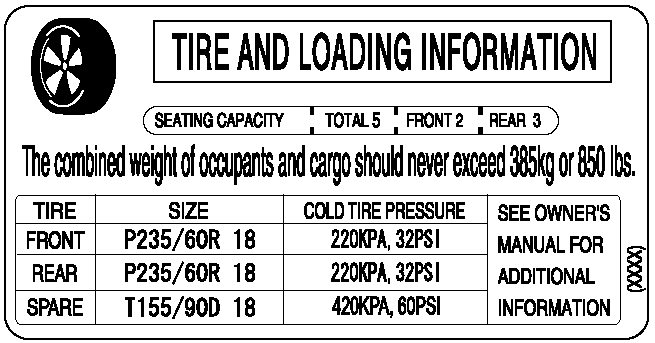Location of the Tire Label (Placard)
You will find the tire label containing tire inflation pressure by tire size
and other important
information on the driver's side B-pillar or on the edge of the driver's door
frame.
SAMPLE

Recommended Tire Inflation Pressure
On the tire label you will find the recommended tire inflation pressure in
both kPa and psi
for the tires installed as original equipment on the vehicle. It is very
important that the
inflation pressure of the tires on your vehicle is maintained at the recommended
pressure.
You should check the tire pressure regularly to insure that the proper inflation
pressure is
maintained.
Refer to Tires.
NOTE:
Tire pressures listed on the vehicle placard or tire information label indicate
the recommended cold
tire inflation pressure, measured when the tires are cold, after the vehicle has
been parked for at least
3 hours. As you drive, the temperature in the tire warms up, increasing the tire
pressure.
WARNING:
Always check the tire inflation pressures on a regular basis according to the
recommended tire inflation pressure on the tire label and in conjunction with
the
information in this owner's manual:
Driving your vehicle with under-inflated tires is dangerous.
Under-inflation is the most common cause of failures in any kind of tire and may
result in severe cracking, tread separation or УblowoutФ, with unexpected loss
of
vehicle control and increased risk of injury. Under-inflation increases sidewall
flexing
and rolling resistance, resulting in heat buildup and internal damage to the
tire. It
results in unnecessary tire stress, irregular wear, loss of control and
accidents. A tire
can lose up to half of its air pressure and not appear to be flat!
It is impossible to determine whether or not tires are properly inflated just by
looking
at them.
Checking Tire Pressure
1. When you check the air pressure, make sure the tires are cold ―meaning
they are not
hot from driving even a mile.
2. Remove the cap from the valve on one tire.
3. Firmly press a tire gauge onto the valve.
4. Add air to achieve recommended air pressure.
5. If you overfill the tire, release air by pushing on the metal stem in the
center of the
valve. Then recheck the pressure with your tire gauge.
6. Replace the valve cap.
7. Repeat with each tire, including the spare.
NOTE:
Some spare tires require higher inflation pressure.
8. Visually inspect the tires to make sure there are no nails or other
objects embedded that
could poke a hole in the tire and cause an air leak.
9. Check the sidewalls to make sure there are no gouges, cuts, bulges, cracks or
other
irregularities.
NOTE:
Warm tires normally exceed recommended pressures. Don't release air from warm
tires to adjust the
pressure.
Under-inflation can cause serious failures and accidents.
Over-inflation can produce a harsh ride and the greater possibility of damage from road hazards.
Glossary of Terms
Tire Placard: A label indicating the OE tire sizes, recommended inflation
pressure, and
the maximum weight the vehicle can carry.
Tire Identification Number (TIN): A number on the sidewall of each tire
providing
information about the tire brand and manufacturing plant, tire size, and date of
manufacture.
Inflation Pressure: A measure of the amount of air in a tire.
kPa: Kilopascal, the metric unit for air pressure.
psi: Pounds per square inch, the English unit for air pressure.
B-pillar: The structural member at the side of the vehicle behind the front door.
Original Equipment (OE): Describes components originally equipped on the vehicle.
Vehicle Load Limit: The maximum value of the combination weight of occupants and cargo.
Bead Area of the Tire: Area of the tire next to the rim.
Sidewall Area of the Tire: Area between the bead area and the tread.
Tread Area of the Tire: Area on the perimeter of the tire that contacts the road
when it's
mounted on the vehicle.
Seating capacity means the total allowable number of vehicle occupants. Seating
capacity
is described on the tire label.
Production options weight is the combination weight of installed regular
production
options weighing over 2.3 kilograms in excess of the standard items which they
replace,
and not previously considered in the curb weight or accessory weight, including
heavy
duty brakes, ride levelers, roof rack, heavy duty battery, and special trim.
Rim is the metal support (wheel) for a tire or a tire and tube assembly upon
which the tire
beads are seated.
See also:
Windshield Wipers
Turn the wipers on by pulling the lever
down.
INT ― Intermittent
LO ― Low speed
HI ― High speed
For a single wiping cycle, push the lever
up to MIST.
MIST ― Mist
Wind ...
Superior Ride Quality
Beside these new suspension components, engineers also re-tuned the
suspension of the Mazda 6 facelift to deliver an even higher quality ride
without compromising Mazda 6's acclaimed handling. The ...
Fully Automatic Type
* Some models.
Climate control information is displayed on the information display.
Without rear ventilation system
With rear ventilation system
Control Switches
AUTO switch
Without rear v ...


